Winter can be a quiet time for birds in Alaska, but there are still more than a dozen species you can regularly attract to a feeder in the state.
Important to read before continuing, the Alaska Department of Fish and Game recommends putting out your bird feeders in the early fall and through the winter until it thaws. In the summer, you should consider taking your feeder down due to bears. If you do put a feeder out in the winter, leave it there through the whole season as birds need a consistent food source!
Because of the ongoing conversation of whether or not to feed birds in the summer in Alaska, I’m omitting a few summer-feeder birds like the Northern Flicker and White-Crowned Sparrow from this list.
With that, below I’ve listed (in alphabetical order) birds you can attract in Alaska, their preferred food, and the top bird feeder options. Also, I’ve provided tidbits based on my experience and some of my top food and feeder picks for birds I’ve had a lot of success with attracting.
Beginner Tips and Types of Feeders and Bird Seed
Before diving into specific birds, here are a handful of universal things you can do to increase your chances of bringing birds to your yard before you even hang up a feeder.
- Provide water (especially a heated bird bath in the winter)
- Avoid using pesticides
- Have trees and shrubbery nearby
- Plant native plants in your yard
- Keep your cats indoors
- Clean your bird feeders every few weeks to prevent disease from spreading
Bird Feeder References (links to examples on Amazon)
Bird Feed References (links to examples)
Mealworms (dried – check out your local bird store for live mealworms!)
Sunflower hearts (no shell or mess)
Looking to save money while bird feeding? I’ve rounded that up in another post.
Authors note: I’m skipping birds of prey, rare, and nuisance birds in this article.
Sources: The Cornell Bird Lab, Audubon Society , The Alaska Department of Fish and Game, and a hefty dose of my firsthand experience. I also get my bird range maps from Wikipedia and credit them as such, while also cross-checking them with other sources.
Disclaimer: Some links found on this page might be affiliate links. If you click an affiliate link and make a purchase, I might earn a commission. As an Amazon Associate I earn from qualifying purchases.
American Robins

What Time of Year?
During the summer throughout most of Alaska.
What’s the Best Food for Robins?
Fruits (apples, oranges, berries, raisins), mealworms. Robins are rare bird feeder visitors, but they’re easy to spot just about anywhere.
Other tips?
I haven’t had luck bringing a robin directly to my feeders. However, they’re familiar visitors in the surrounding area looking for worms and berries in trees. Try putting out diced fruit like apples and you can get lucky.
Black-Billed Magpies

Where?
Black-Billed Magpies are found through much of the Southern-regions of Alaska. Here’s the range map below.

What’s the Best Food for Black-Billed Magpies?
Suet or sunflower seed. Black oil or sunflower chips are both great options.
What’s the Best Bird Feeder for Black-Billed Magpies?
You’re going to want to have a sturdy platform or hopper bird feeder for Black-Billed Magpies. They’re relatively large feeder birds.
Black-Capped Chickadees
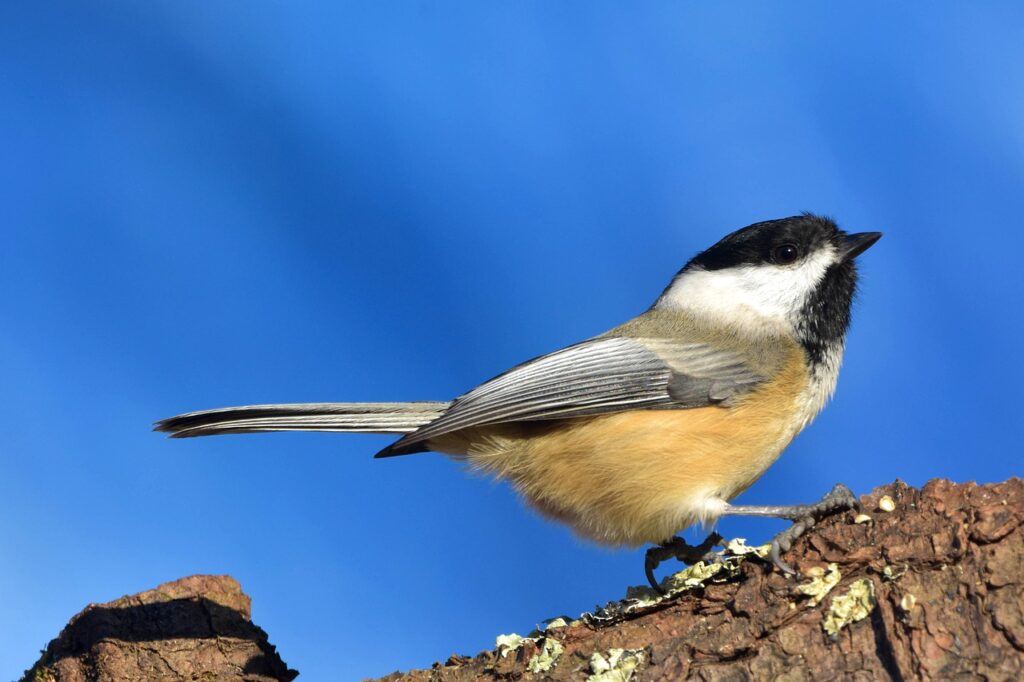
What Time of Year?
Year-round throughout most of Southern and Central Alaska.
What Kind of Food Do Chickadees Like?
Nearly everything. They’re the least picky bird I have at my feeders). So, sunflower seeds, safflower seed, suet, and mealworms are all great.
My Top Amazon Bird Seed Recommendation for Chickadees:
What’s the Best Bird Feeder for Chickadees?
Nearly any feeder. Chickadees aren’t picky!
Related Content: 5 Surefire Tips to Attract Chickadees to Your Bird Feeder
Boreal Chickadees

Where?
Boreal Chickadees are located through much of Alaska, except the Western-regions. Range map linked here (it wasn’t formatting well on my blog).
What’s the Best Food for Boreal Chickadees?
Very similar to Black Capped Chickadees – Sunflower seeds, safflower seed, suet, and mealworms.
Other Tips?
These birds are tougher to spot and attract than Black Capped Chickadees. However, they seem to be quite tame with people if you’re in their neighborhood. They will also be drawn to nest in bird houses in the summer. Learn everything here on the Cornell NestWatch.
Canada Jays (AKA: Gray Jay)

Where?
Canada Jays are found throughout much of Alaska. Range map on Wikipedia linked here for specifics.
What’s the Best Food for Canada Jays?
Canada Jays will eat most bird seed at a tube, hopper, or platform feeder. Aim to have suet and sunflower seed out for these fellas.
Other tips?
Canada Jays are remarkably tame around people. So, if you’re patient, you may be able to convince them to eat a peanut or sunflower seed straight from your hand!
Common Redpolls

What Time of Year?
Common Redpolls are found year-round in the Southern-half of Alaska. They also can be found in the Northern-most parts of the state during their spring/summer migration and nesting season. A link to a range map by Cornell can be found here.
What’s the Best Bird Seed for Redpolls?
They particularly like Nyjer seed and also sunflower chips.
My Top Amazon Bird Seed Recommendation for Redpolls:
Wild Delight Special Finch Food
What’s the Best Bird Feeder for Redpolls?
A tube feeder is best (but any feeder will work).
Dark-Eyed Juncos

The Range of Dark Eyed Juncos
Yellow – Summer Breeding Range, Green – Year-Round Range, Blue – Wintering Non-Breeding Range.
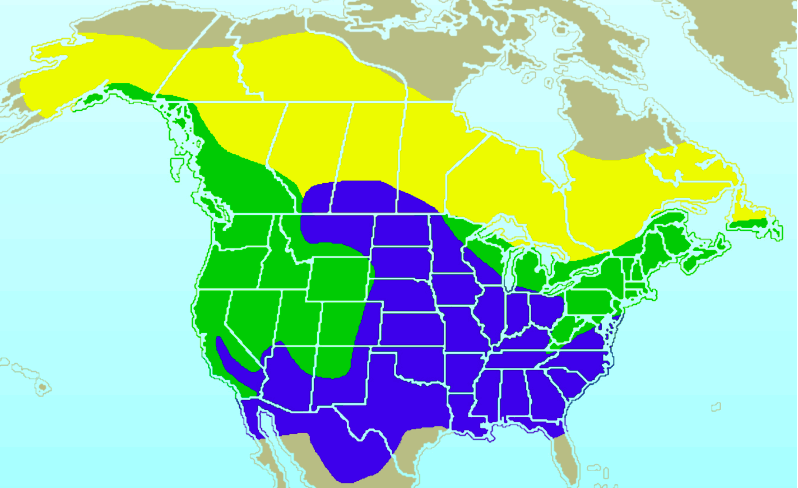
What’s the Best Bird Seed for Juncos?
Millet (best bet), hulled sunflower seed, cracked corn, peanut hearts.
My Top Amazon Bird Seed Recommendation for Juncos:
What Kind of Bird Feeder is Best for Juncos?
A ground feeder. Leftover seed knocked down from hanging feeders will also suffice.
Downy Woodpeckers

What Time of Year?
Downy Woodpeckers can be found through much of Southern and Central Alaska.
What Kind of Food do They Like?
Suet (top choice – especially peanut flavored), will also eat sunflower seeds on occasion
What’s the Best Bird Feeder for Downy Woodpeckers?
Suet feeders of all types (they aren’t picky).
My Top Amazon Bird Feeder Pick For Downy Woodpeckers:
Wildlife Sciences Suet Plug Feeder
Other tips?
Once you attract a Downy Woodpecker to your feeders, they’ll likely be back every single day. I’ve had a pair of Downy Woodpeckers visiting my feeders for about a year now. They show up like clockwork.
Related Content: The Ultimate Guide to Attract Woodpeckers to Your Bird Feeders
Hairy Woodpeckers
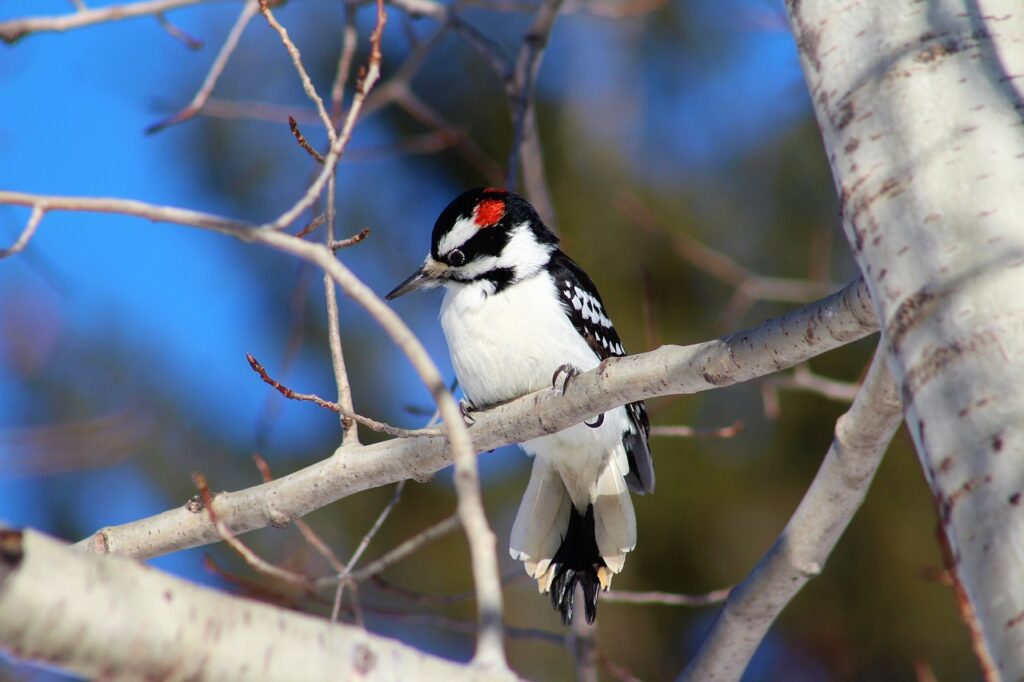
What Time of Year?
Year-round throughout much of South and Central Alaska.
What Kind of Food do Hairy Woodpeckers Like?
Suet (top choice – especially peanut flavored), will also eat sunflower seeds
What’s the Best Bird Feeder for Hairy Woodpeckers ?
Suet feeders of all types. I have Hairy Woodpeckers who visit my suet log feeder.
Other tips?
If you have dead trees in your yard, consider leaving them for Hairy Woodpeckers to nest in!
Pine Grosbeaks

What Time of Year?
Year-round throughout much of Alaska.
What’s the Best Bird Seed for Pine Grosbeaks?
Sunflower seeds (best choice) and suet.
What’s the Best Bird Feeder for Pine Grosbeaks?
Large tube, platform, and hopper feeders.
Other tips?
According to The Cornell Bird Lab, Pine Grosbeaks may also be seen eating grit near roads by forests.
Pine Siskins

Where?
Purple: Year-Round, Blue: Winter, Orange: Summer
Source: Cephas, Wikipedia
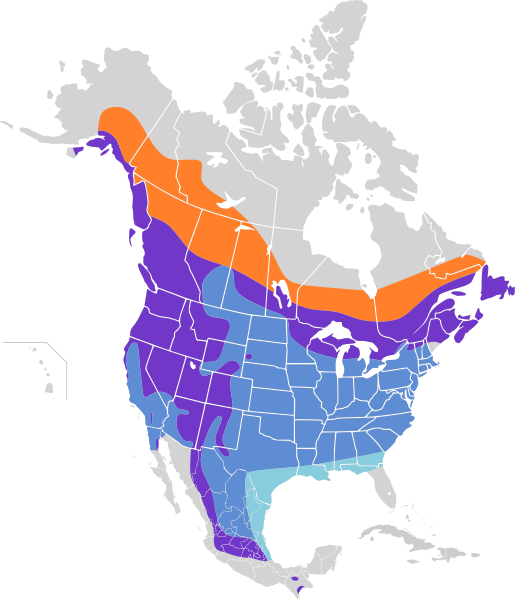
Purple: Year-Round
Dark Blue: Winter
What’s the Best Bird Seed for Pine Siskins?
Nyjer seed, hulled sunflower seeds, suet (maybe).
My Top Amazon Bird Seed Recommendation for Pine Siskins:
Wild Delight Special Finch Food
What’s the Best Bird Feeder for Pine Siskins?
Nearly anything! The Pine Siskin that visits me often loves the large tube feeder I have with a finch blend.
Other tips?
This is an erratic bird feeder visitor based off its food supply and migration. The Cornell Bird Lab says: “Flocks of tiny Pine Siskins may monopolize your thistle feeder one winter and be absent the next”. Be patient!
Red-Breasted Nuthatches

What Time of Year?
Year-round in South-Central Alaska. Check the range map below!
Purple: Year-Round, Blue: Non-breeding
Credit: Cephas, Wikipedia
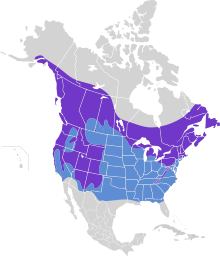
What’s the Best Food for Red Breasted Nuthatches?
Peanuts, suet and sunflower seeds
What’s the Best Bird Feeder for Red Breasted Nuthatches?
Almost anything
Other tips?
Offer an assortment of seeds on a variety of feeders to attract nuthatches. They will often sample several seeds before picking their favorite and fly off.
Red Crossbills
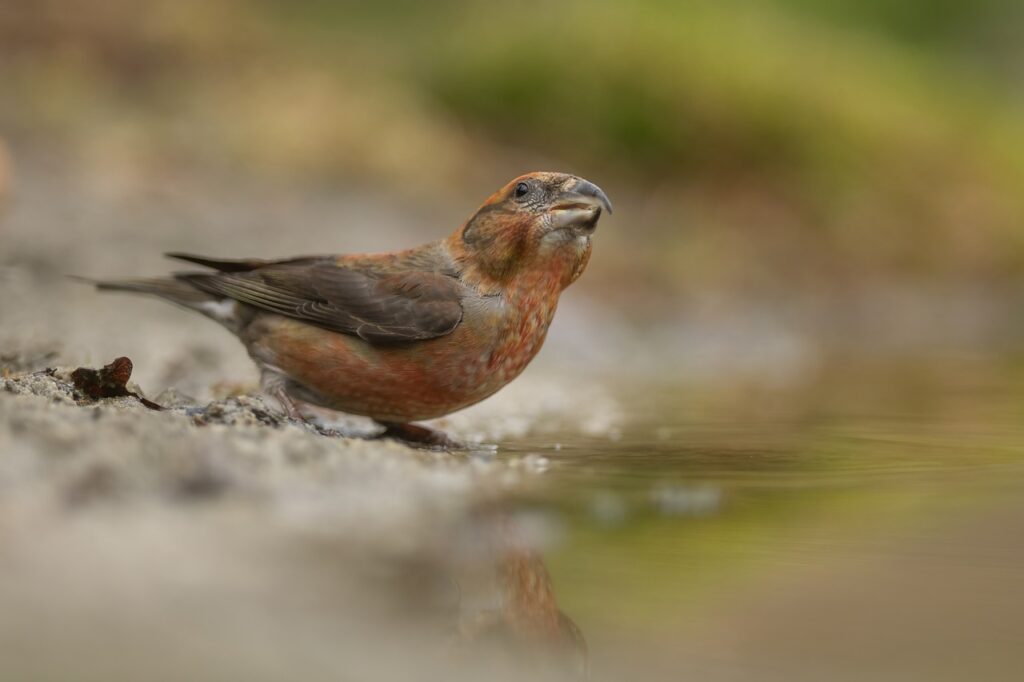
Where?
In the South-Southeast areas of Alaska. Full range map linked here.
What’s the Best Food for Red Crossbills?
Sunflower seed (best choice) and thistle seed.
What’s the Best Bird Feeder for Red Crossbills?
A tube feeder will be your best bet.
Other Tips?
Red Crossbills love pine trees and eat seed from pinecones. This may be an even better bet to get them visiting versus a bird feeder.
Song Sparrows

Where?
Found year-round on the Southern and Southeastern areas of Alaska.
What’s the Best Food for Song Sparrows?
A common bird feeder visitor! Song Sparrows love just about everything. I’ve had the best luck with white millet and sunflower seed.
What’s the Best Bird Feeder for Song Sparrows?
Song Sparrows will gladly eat off the ground or a platform feeder.
Steller’s Jays
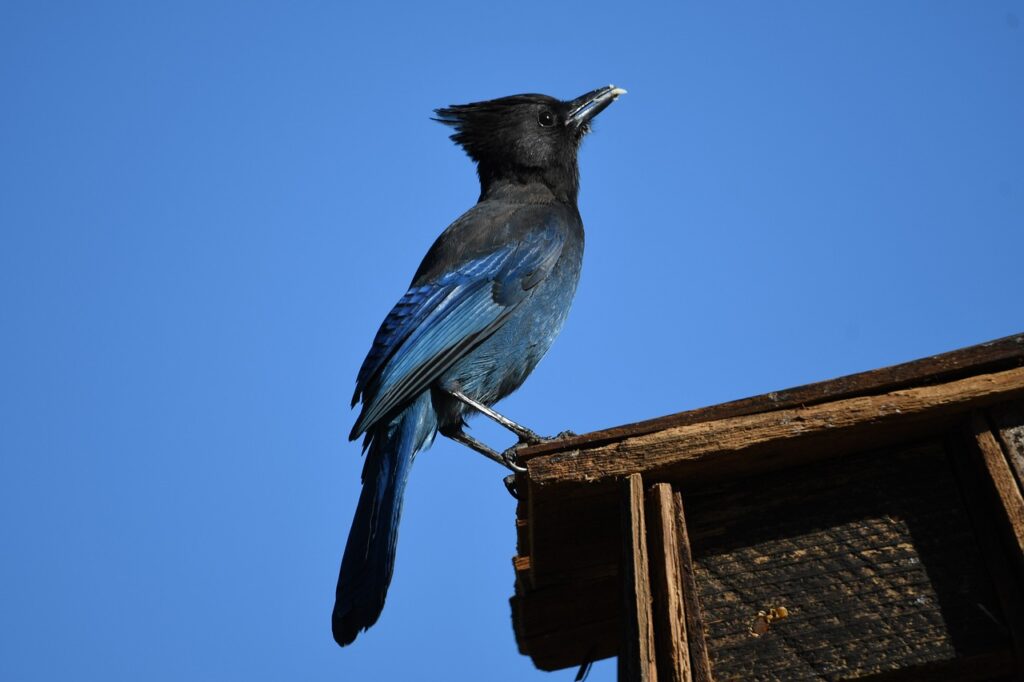
Where?
Year-round on the South and Southeastern areas of Alaska.

What’s the Best Food for Steller’s Jays?
What’s the Best Bird Feeder for Steller’s Jays?
Get a sturdy hopper or tray feeder to support Steller’s Jays. They may also visit suet cage feeders.
Other Tips?
Like Blue Jay’s, Steller’s Jays will take food from bird feeders to cache it for later! These birds are common both in forested areas and backyards.
